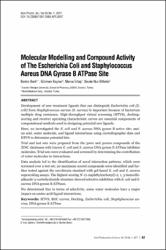| dc.contributor.author | Berk, Barkın | |
| dc.contributor.author | Kaynar, Gürmen | |
| dc.contributor.author | Ertaş, Merve | |
| dc.contributor.author | Biltekin, Sevda Nur | |
| dc.date.accessioned | 10.07.201910:49:13 | |
| dc.date.accessioned | 2019-07-10T19:36:14Z | |
| dc.date.available | 10.07.201910:49:14 | |
| dc.date.available | 2019-07-10T19:36:14Z | |
| dc.date.issued | 2017 | en_US |
| dc.identifier.citation | Berk, B., Kaynar, G., Ertaş, M. ve Biltekin, S.N. (2017). Molecular modelling and compound activity of the escherichia coli and staphylococcus aureus DNA gyrase B ATPase site. Acta Pharmaceutica Sciencia, 55(1), 97-117. https://dx.doi.org/10.23893/1307-2080.APS.0557 | en_US |
| dc.identifier.issn | 1307-2080 | |
| dc.identifier.uri | https://hdl.handle.net/20.500.12511/1105 | |
| dc.identifier.uri | https://dx.doi.org/10.23893/1307-2080.APS.0557 | |
| dc.description.abstract | Development of new treatment ligands that can distinguish Escherichia coli (E. coli) from Staphylococcus aureus (S. aureus) is important because of bacterium multiple drug resistance. High-throughput virtual screening (HTVS), docking-scoring and receiver operating characteristic curves are essential components of computational methods used in designing potential new ligands. Here, we investigated the E. coli and S. aureus DNA gyrase B active site; amino acid, water molecule, and ligand interactions using crystallographic data and HTVS to determine potential hits. Trial and test sets were prepared from the 5000 and 50000 compounds of the ZINC databases with known E. coli and S. aureus DNA gyrase B ATPase inhibitor molecules. Trial sets were evaluated and screened by determining the contribution of water molecules to interactions. Data analysis led to the identification of novel interaction patterns, which were screened over a test set; 20 maximum scored compounds were identified and further tested against the novobiocin standard with gel-based E. coli and S. aureus supercoiling assays. The highest scoring N’-(1-naphthylcarbonyl)-2, 1, 3-benzothi-adiazole-5-carbohydrazide structure showed selective inhibition with E. coli and S. aureus DNA gyrase B ATPases. We determined that in terms of selectivity, some water molecules have a major impact on amino acid-ligand interactions. | en_US |
| dc.language.iso | eng | en_US |
| dc.publisher | University of Istanbul | en_US |
| dc.rights | info:eu-repo/semantics/openAccess | en_US |
| dc.subject | DNA Gyrase B ATPase | en_US |
| dc.subject | Docking | en_US |
| dc.subject | Escherichia Coli | en_US |
| dc.subject | HTVS | en_US |
| dc.subject | ROC Curves | en_US |
| dc.subject | Staphylococcus Aureus | en_US |
| dc.title | Molecular modelling and compound activity of the escherichia coli and staphylococcus aureus DNA gyrase B ATPase site | en_US |
| dc.type | article | en_US |
| dc.relation.ispartof | Acta Pharmaceutica Sciencia | en_US |
| dc.department | İstanbul Medipol Üniversitesi, Eczacılık Fakültesi, Eczacılık Meslek Bilimleri Bölümü, Farmasötik Kimya Ana Bilim Dalı | en_US |
| dc.authorid | 0000-0001-6047-2796 | en_US |
| dc.authorid | 0000-0002-2289-7950 | en_US |
| dc.authorid | 0000-0003-1896-2729 | en_US |
| dc.identifier.volume | 55 | en_US |
| dc.identifier.issue | 1 | en_US |
| dc.identifier.startpage | 97 | en_US |
| dc.identifier.endpage | 117 | en_US |
| dc.relation.publicationcategory | Makale - Uluslararası Hakemli Dergi - Kurum Öğretim Elemanı | en_US |
| dc.identifier.doi | 10.23893/1307-2080.APS.0557 | en_US |
| dc.identifier.scopusquality | Q4 | en_US |


















